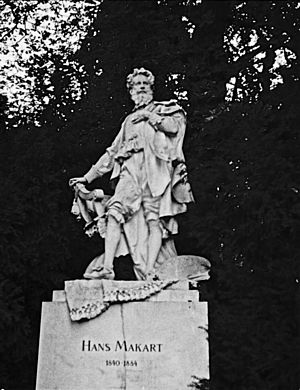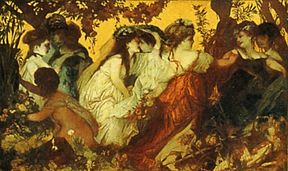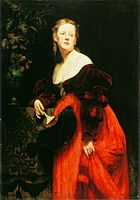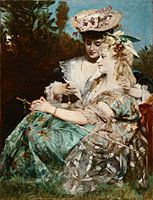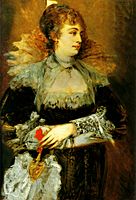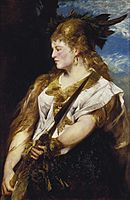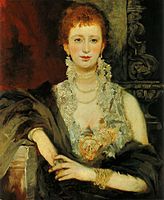Hans Makart facts for kids
Quick facts for kids
Hans Makart
|
|
|---|---|

Hans Makart, Self-portrait, 1878
|
|
| Born | 28 May 1840 Salzburg, Austria
|
| Died | 3 October 1884 (aged 44) Vienna, Austria
|
| Nationality | Austrian |
| Education | Vienna Academy (1850-1851); Karl Theodor von Piloty, Munich |
| Known for | Painter, draughtsman, designer and decorator |
| Movement | Academic history painting; Orientalist |
Hans Makart (born May 28, 1840 – died October 3, 1884) was a famous Austrian artist from the 1800s. He was a painter, designer, and decorator. Makart created many artworks and his ideas greatly changed art in Austria-Hungary, Germany, and other places.
Life of Hans Makart
Hans Makart was born in Salzburg, Austria, the same city where Mozart was born. His father worked at the Mirabell Palace. Hans first studied painting at the Vienna Academy from 1850 to 1851. His teacher was Johann Fischbach.
At that time, German art focused on clear drawing and precise shapes. But Makart loved colors more than drawing. His teachers thought he wasn't talented enough, so he had to leave the Vienna Academy.
Makart then moved to Munich. After two years of learning on his own, he caught the eye of Karl Theodor von Piloty. Piloty helped Makart develop his painting style between 1861 and 1865. During these years, Makart also traveled to London, Paris, and Rome to learn more about art.
His first painting under Piloty, Lavoisier in Prison, showed his good use of color. In his next work, The Knight and the Water Nymphs, he showed his talent for decorative art. He became famous with Modern Amoretti and The Plague in Florence. The Austrian emperor bought his painting Romeo and Juliet for a museum in Vienna. Soon, Makart was invited to live and work in Vienna by important people.
Prince Von Hohenlohe gave Makart an old factory building to use as his art studio. Makart filled his studio with sculptures, flowers, musical instruments, and jewelry. He used these items to create beautiful backgrounds for his portraits, especially of women. His studio became a popular meeting place in Vienna for high society. People like Cosima Wagner described it as a "wonder of decorative beauty." Makart's fancy studio even inspired how many wealthy homes were decorated.
Makart became a very important artist in Vienna. The city was very active in art during the 1870s. He not only painted, but also designed interiors, costumes, and furniture. His work decorated many public buildings. His unique style became known as "Makartstil" or "Makart style," and it defined the art of that time.
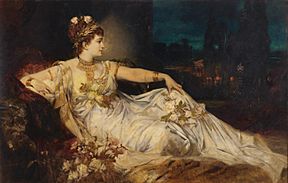
In 1879, Makart designed a huge parade to celebrate the 25th wedding anniversary of Emperor Franz Joseph I and Empress Elisabeth of Bavaria. He designed all the costumes, decorations, and parade floats himself. This event, called the "Makart-parade," allowed people in Vienna to dress in historical costumes and feel like they were back in the past. Makart himself led the artists' float on a white horse. These festivals became a tradition in Vienna that lasted until the 1960s. In the same year, Makart became a professor at the Vienna Academy.
Makart's painting The Entry of Charles V into Antwerp caused some discussion. In the United States, a man named Anthony Comstock tried to ban the painting. This made Makart even more famous because people wanted to see what Comstock was trying to hide.
In 1882, Emperor Franz Joseph I ordered a villa called the Hermesvilla to be built for his empress. He wanted the bedroom to be decorated with scenes from Shakespeare's A Midsummer Night's Dream. Makart designed a beautiful painting for this, but he died in 1884 before it could be finished. After his early death, his large collection of art and antiques was sold at an auction.
Today, a square in Salzburg is named Makart Square (Makartplatz) in his honor.
Makart's Artistic Style
The "Makartstil" was a unique art style that shaped the culture of Vienna. Makart was called the "magician of colors" because he used bright colors and flowing shapes. For him, the beauty and design of the artwork were most important. To make his colors even stronger, he sometimes added asphalt to his paint. This has caused some of his paintings to fade over time.
His paintings were usually very large and dramatic, often showing historical events. Works like The Papal Election show how skilled Makart was at using bold colors to create excitement.
Makart was very interested in how all the visual arts could work together. He believed in the idea of a "Gesamtkunstwerk" or "total work of art." This meant combining painting, design, and other arts into one grand experience. He achieved this in the magnificent festivals he organized, especially the 1879 Makart-parade. Makart was also friends with the composer Richard Wagner. Both artists explored similar ideas in their work, using history and myths to create beautiful, grand displays.
Makart's art, like that of other artists of his time, often included allegorical (symbolic) and historical themes. Examples include Catherina Carnaro, Dianas Hunt, The Entry of Charles V into Antwerp, Abundantia, Spring, Summer, The Death of Cleopatra, The Five Senses, and Bacchus and Ariadne. He was seen as Austria's rival to the French artist William-Adolphe Bouguereau. In Austria, his main competitor was Hans Canon. Makart also worked with the sculptor Viktor Tilgner.
Makart's Influence on Art
Makart had a clear impact on the art and culture of Vienna. He also influenced many painters and designers who came after him, even some who later created different styles. One of the most famous artists he influenced was Gustav Klimt, who admired Makart greatly. Klimt's early paintings show clear similarities to Makart's style.
The focus on decorative art in the Vienna Secession, an Austrian art movement similar to Art Nouveau, came from the environment Makart created. He had already made the decorative side of art very important.
Works
- Hans Makart's paintings
See also
 In Spanish: Hans Makart para niños
In Spanish: Hans Makart para niños
- List of Orientalist artists
- Orientalism


